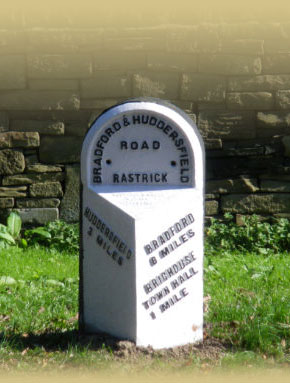HIGHWAYS HERITAGE WALKS
Ripponden – hills and valley
Walk Length: 3½ miles – allow at least 2 ½ hours.
Grade: The route is medium, on steep cobbled tracks, paths and roads, caution needed if wet underfoot. Not suitable for the mobility impaired or young children.
The milestones and other waymarkers may be viewed from a car, with care.
Grid Reference: 53 deg 40’ 31.45” N
1 deg 56’ 27.48” W
Postcode: The Old Bridge Inn, Priest Lane/Old Bank, Ripponden OS SE 0419; HX6 4DF.
Public transport: Ripponden is accessible by bus numbers 681, 682, 548, 549, 509, 534, 227, 508, 226 from the Halifax, Bradford, Brighouse, Huddersfield and Leeds bus stations. Rail station: Halifax.
Parking: on roadsides by St Bartholomew’s/ the Community Centre or in the car-park on Royd Lane, behind the Conservative Clubhouse (2 hours in daytime ).
Description
The walk starts at the heart of Ripponden, an ancient township on the junction of the roads between Halifax-Rochdale and Elland – Saddleworth. We walk towards Halifax, viewing a tollhouse and various waymarkers, then along the Ryburn riverside and up a steep packhorse track to join the Calderdale Way, with spectacular views. Hardy souls may continue to Barkisland to see more waymarkers, otherwise we return, examining an ancient milestone on the way back to our starting point.
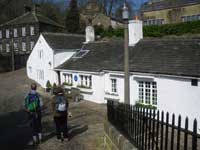
1 Bridge Inn

2 St Barts & bridge
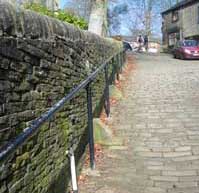
3 Priest Bollards

4 Corner Milestone
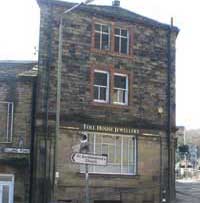
5 Tollhouse
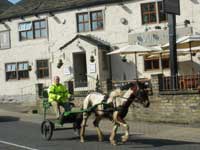
6 Trap & Milestone Restaruant

7 A milestone section
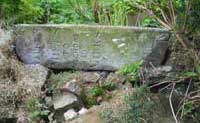
8 Part-milestone

9 Repainted with the number 3
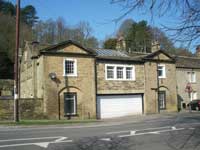
10 Coach House
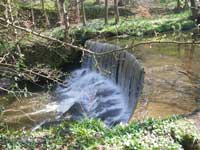
11 Weir
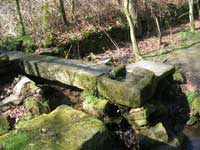
12 Stone Drinking Trough
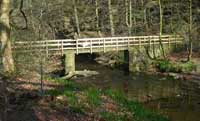
13 Bridge
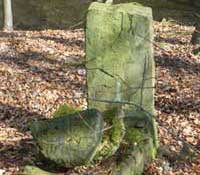
14 Marker stone
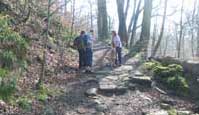
15 Substantial stones and setts
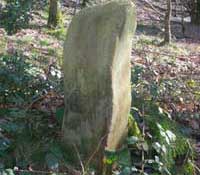
16 Guidepost or stoop
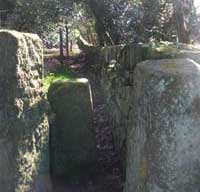
17 Shortcut
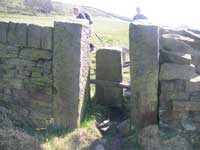
18 Squeeze Style
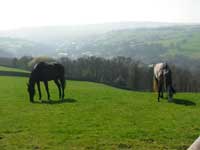
19 Extensive views
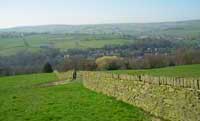
20 Admire the switchback dry-stone walls
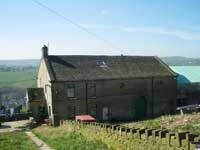
21 Yorkshire long-house
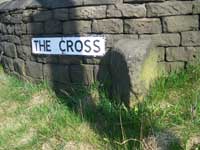
22 The Cross
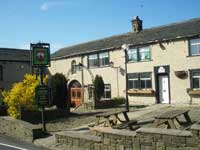
23 The Fleece
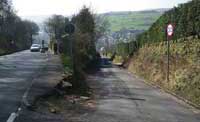
24 Old Bank

25 Water Features
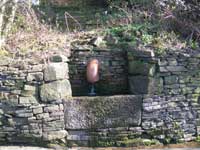
26 Water Features
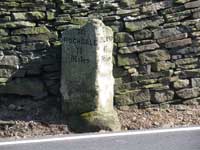
27 C 18th turnpike stone
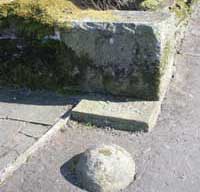
28 Bollard

29 Old School House
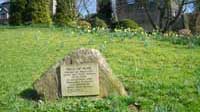
30 Field of Hope
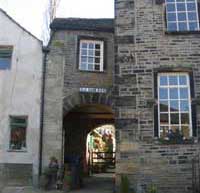
31 Picturesque archway
Route Instructions
Our journey starts 1 outside the Old Bridge Inn, ‘probably’ the oldest inn in Yorkshire, first recorded in 1307 as the home of a yeoman clothier. We can see the old bridge on the right, beneath the current one over the river Ryburn, with the watermill race. 2. The splendid St Bartholomew’s Church overlooks the river Ryburn and a stream called Cob Clough runs under the grave yard in front of the church. This is the fourth church to stand on this site; the second church and a considerable proportion of the graveyard were washed away in May 1722 when the stream flooded.
Turn up the cobbled Priest Lane, where the vicarage of St Bartholomew’s is situated. Note the bollards 3 at intervals in the base of the wall on the left-hand side; these were used to stop carts running away down the slope or from hitting the wall.
Turn left when you reach the A58 Halifax Road.
The Halifax-Rochdale Road with its branch to Elland was the first route to cross the Pennines, turnpiked in 1735. Because road travel was slow and difficult and better trade routes were needed, Turnpike Trusts (groups of local worthies) were set up by Acts of Parliament from 1706 to 1840s, to repair and later to extend the highway network. Users were charged tolls to pay for this work. The name ‘turnpike’ comes from the spiked barrier at the Toll Bar. From 1767, mileposts were compulsory on all turnpikes, not only to inform travellers of direction and distances, but to help coaches keep to schedule and for charging for changes of horses at the coaching inns.
Walk to the corner to find a milestone, 4 patiently awaiting restoration after being defaced in WWll to baffle any German invaders. On the right hand corner is the Tollhouse Jewellery shop, 5 probably the scene of many arguments about the tolls charged, which were resented by travellers. Over the road is the Milestone Restaurant, 6 previously known as the Golden Lion.
Retrace your steps and continue along the Halifax Road, passing BrigRoyd Surgery, to cross at the pedestrian lights. Turn right to continue along the Halifax Road, taking the footway beside the pillar box. Follow this pavement as it bears left at the end of the houses ( No. 42) and walk up past the beech hedge, cross diagonally to your right, to a green wrought-iron gate. The right-hand gatepost conceals a milestone section inscribed ‘Elland 4 ¾ miles’. 7 Turn back down-hill, following the wall. As you turn the corner leftwards, opposite 188 there is another part-milestone lying face down on top of the wall!8.
Crawshaws the local builders and quarry-owners owned these cottages; they retained pieces from buildings they demolished and these milestones may be part of their collection.
Continue along the back way and turn right at the end, down a setted lane to the Halifax Road and turn left. Cross the road with care at the ’40 mph’ sign; the original milestone 9 here has been repainted with the number 3 instead of 5 miles to Halifax.
Continue along the pavement noting the substantial Victorian coach-house on the opposite side of the road. 10 At the playing field, enter and walk down to the permissive path that runs alongside the wall, to the riverside. There is a stile by the riverbank; notice the winding gear for the sluices to your right.
Turn left along the river bank, noting the cascading torrent of the weir 11 and the high wall supporting the railway embankment on the far side.
Our first wayside water-feature is a stone drinking trough, fed by a raised channel. 12
As the bridge comes into view, 13 note a marker stone on the bank on your right 14 and then an irrigation ditch on your left, with large stone chambers.
Join the old packhorse track as it drops down from your left from Kebroyd and cross the bridge. Bear right up the path, noting the substantial stones and setts that still pave it. 15
After the Romans left, there was no systematic road construction until the turnpikes. Goods were carried by packhorses through the Middle Ages and later, because the highways were not suitable for wheeled vehicles; usually a flagged stone causeway was the best surface, often with a sunken lane or holloway alongside, to permit passing. From 1555, the parishes and townships were made responsible for the maintenance of their roads. Individuals had to provide compulsory labour or a payment in lieu, the earliest form of ‘rates’ or council tax called the Composition – which was most unpopular. From 1697, the Justices were required to erect waymarkers (‘stoops’) on the moors and where tracks crossed, to guide travellers.
Continue up the path and cross left over the bridge of the old Lancashire and Yorkshire railway (1878).
Turn left and climb the rough track through ancient woodland to a house. Keep to the path as it passes to the right of the house, then it doubles back to the right in a U-bend. Follow the path uphill, noting a guidepost or stoop 16 in the wall on the left as you climb. Follow the wall to the left as it bends, past a sunny grassy bank, good for a refreshment stop at the half-way point of the walk.
Continue up the track. Just before a large stone gatepost, there’s a footpath marked ‘beware of the bull’ through a squeeze stile on the right, 17. This is a shorter way back to the starting point but can be very boggy so we proceed uphill as the woodland opens into fields. Take the Calderdale Way signposted to your right, through a squeeze stile, 18 noting a stone-walled corral further up the path. Enjoy the extensive views to the windfarm at Ogden Water and up the Ryburn valley. 19.
Follow the Calderdale Way path along the wall. The springs can make it boggy; if so, walk higher up the field. Through the stile by a gate, there is a thoughtfully-placed seat as underfoot becomes a grassy track. Admire the switchback dry-stone walls 20 traversing the hilly landscape and the example of a crenellated top on the substantial wall of the track.
Go through the gap stile, past a Yorkshire long-house, 21 being extended. The track is hard-surfaced now. Pass Moorbottom House, noticing another walled track that once accessed the hilltop. At the end of the track is the Ripponden to Elland branch of the turnpike, forking to Greetland. Turn left to find ‘The Cross’, 22 with a triangular stone against a drystone wall between the forked roads. This is reputed to be the base of a cross, although the cross appears to have been situated at the next junction towards Barkisland, so the stone may be a boundary marker.
The hardy may wish to extend their wander to Barkisland to see a cast-iron milestone on Saddleworth Road and a defaced milestone on Greetland Road, but our walk turns back to Ripponden. Walk down the pavement on the left-hand side. Shortly you will see The Fleece, 23 with its date-stone over the door, D – I*M 1737, a coaching inn with its archway to the stables in the yard. The inns provided changes of horses approximately every fourteen miles.
Passing Bank View House, cross the road. You can bear right down Old Bank 24 following the Calderdale Way back to the start point, but we continue down the pavement of New Bank, watching the old track descending below and noting the narrow walled path down to the church from opposite Mount Pleasant.
Two more ‘water features’ may be seen on the left ! 25 & 26 As the road begins to bend sharply to the right, look across to an original 18th century turnpike milestone, one of the oldest milestones you are likely to see. 27 The legend was carved with Roman numerals, Xl miles to Rochdale and (probably) llll miles to Elland. These have been re-cut later with Arabic numbers. The stone also bears a benchmark; these OS height indicators were often put on milestones because the latter were less liable to be moved than were gateposts or walls.
Continue down the righthand pavement; our last water feature is a stream running far below, under a high wall; a bollard 28 now almost obliterated by the tarmac once protected the bridge wall.
As you pass the old School House, 29 turn right down a short flight of steps by some black iron railings, to join the road from the Old Bank. Admire the interesting historic buildings, turning left past the Field of Hope 30 and looking back at the picturesque archway of no’s 8 & 9 Old Bank. 31
You have now returned to the start point; there are plenty of inns and other pleasant venues in Ripponden to enjoy refreshments.
Our thanks are due to Alan Watson of the Ryburn History Society for his assistance in preparing this walk.
The Milestone Society, established in 2001, campaigns for conservation of milestones and other waymarkers, which are endangered by neglect, by vandalism and by casual destruction, and aims to share our interest in these fascinating pieces of history.
You can find out more about our work plus details of the c9000 milestones in the UK by visiting our website, www.MilestoneSociety.co.uk
While care has been taken to ensure the information above is accurate, the Milestone Society accepts no liability for any claim, loss, damage or injury (howsoever arising) incurred by those using the information provided. Please ensure that you wear suitable footwear and always carry a drink and a snack.


